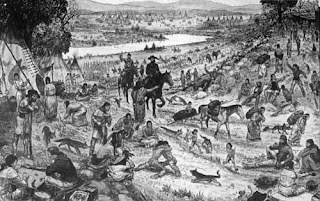The Rocky Mountain Rendezvous, 1825-1840
Some of the first Europeans to explore the west and make contact with Native tribes were trappers and guides, known to history as mountain men, who worked for large fur companies, including Hudson's Bay Company (British) and American Fur Company (American). Due to the sheer size of the territories over which they roamed, there had to be a means for the companies to collect the furs and distribute supplies to keep the men in the field for the coming year. Because many of the early trappers were French Canadian in origin, much of the jargon associated with their work was French, hence the rendezvous.
Between 1825-1840, fur companies would arrange to transport large supplies of liquor and trade goods to a set meeting point, usually in Utah, Wyoming or Idaho. Trappers would flock to the rendezvous, bringing their annual catch of beaver and other pelts to trade for supplies. Natives attended these gatherings, too, often bringing their own furs to trade for liquor, firearms or other supplies. As with any occasion where men gathered to celebrate after months of hard work, the rendezvous was a place of music, story-telling, competitions and private amusements, too. Some trappers and traders developed relationships with Native women, often officially condoned by the tribes in question. These women provided vital links to their husbands, either in terms of being allowed to hunt and tribe in otherwise off-limits tribal range, or just for survival. At the end of several weeks of trading and merrymaking, the furs would be loaded up, headed for Fort Vancouver in Canada, or St. Joseph, Missouri and the yearly cycle would begin again. The rendezvous ended as the beaver trade became less important and major fur companies either folded or found other markets.
Between 1825-1840, fur companies would arrange to transport large supplies of liquor and trade goods to a set meeting point, usually in Utah, Wyoming or Idaho. Trappers would flock to the rendezvous, bringing their annual catch of beaver and other pelts to trade for supplies. Natives attended these gatherings, too, often bringing their own furs to trade for liquor, firearms or other supplies. As with any occasion where men gathered to celebrate after months of hard work, the rendezvous was a place of music, story-telling, competitions and private amusements, too. Some trappers and traders developed relationships with Native women, often officially condoned by the tribes in question. These women provided vital links to their husbands, either in terms of being allowed to hunt and tribe in otherwise off-limits tribal range, or just for survival. At the end of several weeks of trading and merrymaking, the furs would be loaded up, headed for Fort Vancouver in Canada, or St. Joseph, Missouri and the yearly cycle would begin again. The rendezvous ended as the beaver trade became less important and major fur companies either folded or found other markets.




Comments
Post a Comment